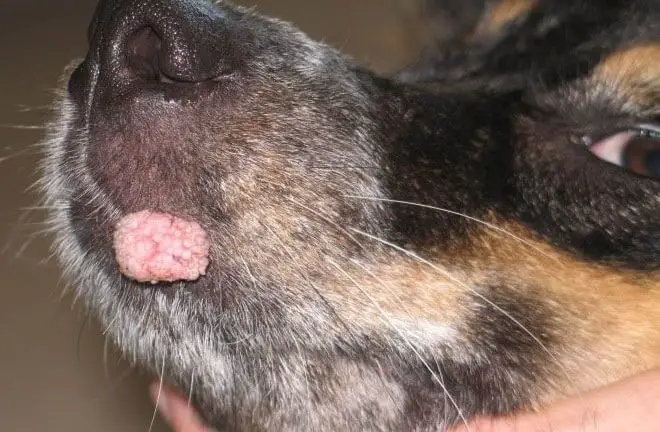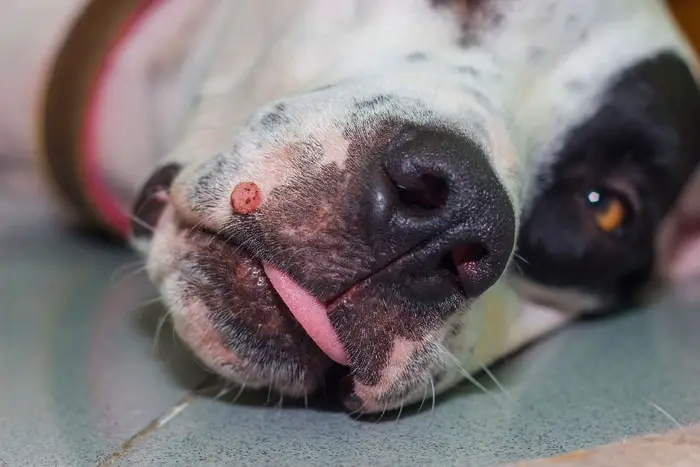Canine papillomatosis or canine oral papilloma infection is a benign mucocutaneous tumor caused by infectious papillomavirus. The highly species-specific virus is responsible for developing large papillomas, also called warts or verruca Vulgaris in and around the mouth. The virus is transmissible to other dogs.
Papillomatosis is a viral infectious disease of dogs and many other domestic animals. COPV is associated with the development of benign, transmissible tumors involving the head, oral cavity, and eyelids. Dogs two years of age and younger appear to be most susceptible. There is no sex or breed predisposition. Malignant transformation of papillomavirus-induced tumors is extremely rare.
What Causes Canine Papilloma?
The infectious papillomavirus causes it. The canine oral papillomavirus (COPV) is a large DNA virus unique to the dog. Although humans, cattle, and even cats have been reported with viral papillomas, viruses belonging to this family are species-specific.

Pathophysiology of Canine Papillomatosis
The tumors induced by COPV are the result of infection of the basal cells of the stratum germinativum resulting in acanthosis and hyperkeratosis. The incubation period ranges from 4-8 weeks following infection. Tumors typically persist for 1-5 months, after which they undergo spontaneous regression.
Symptoms of Oral Papilloma Virus in Dogs
The disease is most likely to occur in young dogs, while the tissues most likely to be affected are the oral mucosa, labial margins, and tongue. Less commonly affected are the palate, pharynx, epiglottis, and esophagus. Alternatively, individual eyelid papillomas may develop on the margin of the eyelids of one or both eyes. Associated signs include-
- Halitosis.
- Hypersalivation.
- Minor bleeding of the affected tissue.
- Discomfort.
- Trauma to proliferating tumors caused by toenails and teeth may spread the tumors within and around the oral cavity.
- Secondary oral ulceration and infection may develop.
- Dogs experiencing high tumor concentration or a huge tumor may find it difficult or painful to eat.
- Subsequently, they become malnourished.
How to diagnose Canine Papillomatosis?
The diagnostic procedures of papillomatosis in dogs are:
- The presumptive diagnosis of infectious papillomatosis is based on physical examination findings and clinical history.
- Diagnostic confirmation of papillomatosis is based on biopsy and gross appearance of these benign tumors.
- The differential diagnosis includes- benign and malignant oral neoplasms, e.g., epulides, fibroma, hemangioma, hemangiopericytoma, and histiocytoma.

How Do You Treat Canine Papillomas?
In most cases, the virus-induced tumor burden is not sufficiently significant to warrant treatment. Spontaneous regression of tumors is standard by 1-5 months following their initial appearance. It is not known why these tumors spontaneously regress or how they spread. Uncommonly, surgical excision, cryosurgery, or electrosurgery is indicated to remove large oral tumors.
It has been reported that simply crushing 5-15 of the tumors may provoke spontaneous regression and, thereby, shorten the course of the disease. The use of systemic and lesional or intralesional treatment with chemotherapeutic agents has not been uniformly effective in your dogs.
Prognosis of Papillomatosis in Dogs
The prognosis for recovery is excellent without specific therapeutic intervention. The tumor normally sheds off after a considerable time.
Prevention of Papillomatosis
In light of failures associated with the one-time availability of a “wart vaccine,” there is currently no licensed biological for use in dogs to prevent canine viral papillomatosis.
Public Health Implications of Canine Papillomatosis
COPV is unique to the dog and, as such, presents no risk to humans. If your lovely pet suffering from canine papillomatosis you need not worry about your health. You can continue the normal behavior with him and give him the necessary support to overcome the problem.